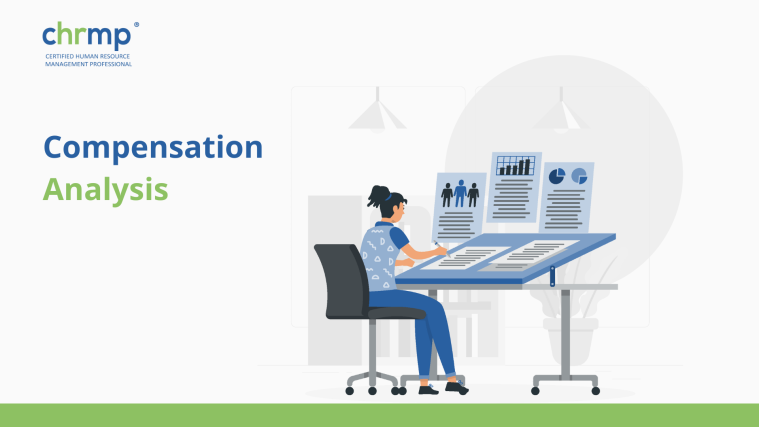

In today’s competitive job market, companies strive hard to stay updated on the latest trends to attract top talent and keep their retention rates high. And a compensation analysis helps with just that.
A well-conducted compensation analysis helps organizations plan attractive compensation packages to maintain a competitive edge over the market and attract and retain highly-skilled employees while improving on several key areas of the company, like job satisfaction.
In this blog, we shall explore the definition, importance, advantages, and the five-step compensation analysis process.
So if you want to upgrade your company’s existing compensation program or enjoy learning about HRM topics, this blog is for you.
So without further ado, let’s get started.
The process of evaluating and comparing salaries, perks, bonuses, benefits and other types of compensation that employees receive in a company is called compensation analysis. It aims to establish a fair compensation program for all employees based on their skill and experience, responsibilities, etc., and to help the company attract top talent.
Analyzing compensation involves examining internal and external factors like performance appraisals, job descriptions, salary structures, geographical location, current market rates, industry trends, etc.
The steps usually involve collecting and analyzing compensation-related data like salary surveys, job descriptions of employees, etc., conducting market research on industry salaries and benefits, and then using the data to create a compensation plan that is tailored to the company’s needs and is fair, competitive and factors in important elements such as experience, performance, and job responsibilities.
Compensation analysis is important for organizations as it helps them maintain a strong foothold in the competitive job market, attract and retain top talent, reduce employee turnover rates, ensure fair compensation, and ultimately drive business success.
Let’s look into it more closely.
Companies can draft an attractive compensation plan and attract the top talented candidates by conducting a compensation analysis. This will lead to a highly-skilled workforce that helps the company gain a competitive edge in the market.
Analyzing compensation will also help the company retain existing talent by making employees feel fairly compensated for the skills and experiences they bring to the company, thus reducing attrition rates.
Fair compensation will also help the company improve key areas like job satisfaction, employee engagement, employee productivity, better customer service, and improved financial performance.
In addition, analyzing compensation can also help identify where the company might be underpaying or overpaying its employees and take measures to address it, thus leading to effective cost-saving and resource utilization.
To summarize, compensation analysis helps companies in several key business areas, like attracting and retaining top talent, increasing employee engagement and productivity, job satisfaction, helping the company gain an edge over competitors, and ultimately achieving business success.
There are several advantages of conducting a compensation analysis for an organization. These include:
1. Attracting and retaining top talent:
Offering competitive and fair compensation packages can help to attract and retain top talent in the organization. When employees feel they are being compensated fairly, they are more likely to stay with the organization and perform at a higher level.
2. Improving employee morale and engagement:
Fair compensation can improve employee morale and engagement, as employees feel valued and appreciated for their contributions to the organization. This can increase productivity, better customer service, and improved financial performance.
3. Identifying cost savings:
Conducting a compensation analysis can help organizations to identify areas where they may be overpaying or underpaying employees. This can lead to cost savings and more effective use of resources.
4. Staying competitive:
By keeping up with market rates and industry trends, organizations can ensure that they are offering competitive compensation packages that attract and retain top talent.
5. Ensuring compliance:
Conducting a compensation analysis can help organizations to ensure that they comply with labour laws and regulations related to compensation.
Overall, a compensation analysis can provide valuable insights for organizations and help ensure that they are compensating their employees fairly and competitively, leading to increased employee satisfaction, engagement, and business success.
Conducting a compensation analysis involves several steps. Here is a general outline of the process:
1. Define the scope and objectives:
When defining the scope and objectives of the compensation analysis, it is important to consider factors such as the specific job roles that will be analyzed, the geographic region or industry in which the organization operates, and the specific goals of the analysis (e.g., ensuring competitive compensation, identifying cost savings opportunities, etc.). This information will help guide the rest of the analysis and ensure it focuses on the most relevant and important factors.
2. Gather data:
Once the scope and objectives have been defined, the next step is to gather the data used in the analysis. This may involve collecting data on employee compensation (e.g., salary, bonuses, benefits), job descriptions and requirements, market surveys, and industry benchmarks. It is important to ensure the data is accurate, up-to-date, and relevant to the specific job roles and industry being analyzed.
3. Analyze the data:
After the data has been collected, it needs to be analyzed to identify patterns, trends, and outliers. This may involve calculating averages, medians, and ranges for various compensation components and identifying any significant deviations from industry benchmarks or market rates. This analysis should be conducted with a focus on identifying any areas where the organization may be overpaying or underpaying employees, as well as any potential cost savings opportunities.
4. Develop a compensation strategy:
Based on the data analysis, the organization should develop a compensation strategy that is designed to address any issues or opportunities identified in the previous steps. This may involve adjusting compensation levels for certain job roles, changing benefit offerings, or implementing new performance-based compensation structures. The strategy should be aligned with the organization’s overall goals and objectives and should take into account any budgetary or resource constraints.
5. Implement and monitor the strategy:
Once the compensation strategy has been developed, it needs to be implemented and monitored over time to ensure that it is achieving the desired results. This may involve communicating changes to employees, adjusting compensation levels as needed, and regularly reviewing and updating the compensation strategy based on new data or changes in the industry or organization. It is important to ensure that the compensation strategy is transparent and fair and that it is effectively supporting the organization’s overall goals and objectives.
Legal compliance is a crucial aspect of any compensation strategy. Ensuring that your organization’s compensation practices align with applicable labor laws and regulations is essential to avoid legal issues and maintain a fair and equitable work environment. Here are key considerations for legal compliance in your compensation strategy:
1.Minimum Wage Laws: Familiarize yourself with the minimum wage requirements set by local, state, and federal laws. Ensure that your organization’s compensation meets or exceeds the minimum wage standards.
2. Overtime Regulations: Understand the laws regarding overtime pay and classification of employees as exempt or non-exempt. Determine eligibility for overtime pay, calculate overtime rates accurately, and maintain proper records of overtime worked.
3. Pay Equity: Pay equity laws prohibit wage discrimination based on gender, race, or other protected characteristics. Conduct regular pay equity analyses to identify any unexplained pay gaps and take appropriate steps to address them.
4. Equal Pay Laws: Comply with equal pay laws that mandate equal compensation for employees performing substantially similar work, regardless of gender. Avoid pay disparities based on gender by ensuring transparent and objective compensation practices.
Compensation analysis and HR tech have become increasingly intertwined, with technology playing a vital role in enhancing the efficiency and effectiveness of compensation analysis processes. Here are some ways in which HR tech is revolutionizing compensation analysis:
1.Data Aggregation and Analysis: HR tech tools enable the collection and aggregation of vast amounts of data from various sources, such as payroll systems, performance management platforms, and external salary surveys. This data can be analyzed using advanced analytics and machine learning algorithms to identify compensation trends, patterns, and outliers.
2. Automation of Processes: HR tech automates manual and time-consuming tasks involved in compensation analysis, such as data collection, calculations, and report generation. This automation reduces errors, saves time, and allows HR professionals to focus on strategic analysis and decision-making.
3. Real-time Market Data: HR tech platforms provide access to real-time market data on compensation benchmarks and industry trends. This data helps organizations stay up-to-date with market rates, ensuring they remain competitive in attracting and retaining talent.
4. Pay Equity Analysis: HR tech tools facilitate pay equity analysis by comparing compensation data across various demographic factors, such as gender and race. This helps organizations identify and address any pay gaps or disparities, promoting fairness and compliance with equal pay laws.
5. Personalization and Total Rewards: HR tech enables the customization of compensation packages based on individual employee preferences, performance, and career progression.
The future of compensation analysis will be characterized by data-driven insights and advanced analytics tools. With the availability of large datasets and technological advancements, companies will be able to analyze employee performance, market trends, and internal pay structures more effectively. Machine learning algorithms and predictive modeling will facilitate the identification of patterns and outliers, enabling organizations to create fair and competitive compensation packages.
There will be an increasing emphasis on pay equity and fairness, with organizations striving to eliminate biases and promote diversity and inclusion. Compensation analysis will play a crucial role in identifying and rectifying any pay gaps based on gender, race, or other factors.
Furthermore, personalized and flexible compensation plans will become more prevalent. As employees seek greater work-life balance and personalized rewards, organizations will need to design compensation packages that cater to individual preferences and performance. Compensation analysis will help in creating dynamic compensation structures aligned with employees’ needs.
1. What is the difference between internal equity and external competitiveness in compensation analysis?
Internal equity refers to the fairness of compensation within an organization, where employees are compensated equitably based on their skills, experience, and job responsibilities. External competitiveness, on the other hand, refers to the competitiveness of compensation in comparison to other organizations in the same industry or region.
2. How often should a compensation analysis be conducted?
The frequency of conducting a compensation analysis can vary depending on factors such as the size of the organization and industry trends. However, it is generally recommended that organizations conduct a compensation analysis at least once every two to three years to ensure that they are offering competitive and fair compensation packages.
3. What data sources should be used in a compensation analysis?
Data sources used in a compensation analysis may include employee compensation data, job descriptions and requirements, market surveys, and industry benchmarks. It is important to ensure that the data sources used are accurate, up-to-date, and relevant to the specific job roles and industry being analyzed.
4. How can organizations ensure that their compensation packages are fair and transparent?
Organizations can ensure that their compensation packages are fair and transparent by conducting regular compensation analyses, implementing transparent compensation policies, and communicating openly with employees about their compensation packages. This can help to build trust and engagement among employees and promote a positive workplace culture.
5. What are some potential challenges or risks associated with conducting a compensation analysis?
Some potential challenges or risks associated with conducting a compensation analysis include ensuring that the analysis is objective and unbiased, ensuring that the data used in the analysis is accurate and relevant, and managing employee expectations and perceptions about compensation. It is important for organizations to carefully plan and execute their compensation analysis to minimize these risks and ensure a successful outcome.
In conclusion, conducting a compensation analysis is a crucial process for organizations to ensure that they are offering fair and competitive compensation packages to their employees.
By analyzing internal and external data sources and developing a comprehensive compensation strategy, organizations can address any issues or opportunities identified in the analysis and ensure that their compensation packages are aligned with their overall goals and objectives.
While there may be challenges and risks associated with conducting a compensation analysis, the benefits of a fair and transparent compensation structure can lead to improved employee engagement, retention, and overall organizational success.
Therefore, it is important for organizations to prioritize regular compensation analyses to ensure they are able to attract and retain top talent in their industry.

Grab Your 25 Free Email Templates Now